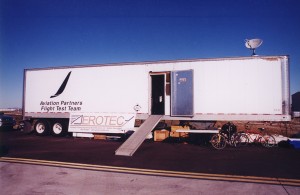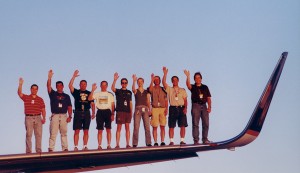By Bob Shane

This Boeing 757-200, parked on the ramp in Tucson, is the newest airliner to be equipped with a blended winglet system.
Arizona has always been a Mecca for aircraft manufacturers and modifiers to bring their new and newly modified airplanes for flight testing. Aviation Partners Boeing recently brought their newest blended winglet-equipped airliner, a Boeing 757, to Tucson to perform the test work needed to get the system certified.
Aviation Partners Boeing has successfully demonstrated the efficacy of its blended winglet system through the numerous installations on next generation Boeing 737-700, 800 and BBJs currently in service. Not only are blended winglets efficacious, but they’re also esthetically pleasing.
The smooth curve of the blended winglet reduces the shock interference between the winglet and wing near the tip. They’re masterfully designed airfoils that tame the drag-producing effects of wingtip vortices, thereby enhancing aircraft performance in a number of different ways. Their main purpose is to save fuel in cruise and improve takeoff climb performance. The block fuel credit improvement can be as much as 5 percent. This fuel credit, however, could be used in other ways. It can be traded for additional payload, speed or range.
The initial launch customers will be Continental Airlines and Icelandair. On March 9, a Continental Airlines Boeing outfitted with a pair of blended winglets, each 8 ft. 2 in. tall, made its first winglet-enhanced flight from Everett, Wash. to Los Angeles. Aviation Partners Boeing expects to enhance the performance of the majority of some 600 plus 757-200s, which make up the existing fleet, through the application of blended winglet technology.
A popular airliner, 1,050 Boeing 757s were built. There are 1,030 B-757s still in service. Ironically, the last 757 was delivered to Shanghai Airlines on April 22, 2005. This milestone airplane marked the end of a successful production run that spanned 23 years. Also in April, the first 757 with a blended winglet system completed flight testing. It too is a milestone airplane.
Prior to installing the blended winglet technology, the Continental 757 had spent a month in Tucson earlier in the year doing what is known in engineering parlance as baseline testing. This phase one evaluation is a flight test program to establish the performance levels of the “stock” aircraft without a winglet system.
Tucson was selected for flight test because of the consistency of its good weather and the airspace available for testing. The technicians are able to start taking data within five minutes of takeoff. The majority of the test area extended 200 miles east of Tucson to El Paso and 200 miles west over the Pacific Ocean. After the baseline testing was completed, the aircraft returned to Washington, where the blended winglet system was installed at Goodrich.
In March, the 757 returned to Tucson for the phase two evaluation, which was with the winglets installed (the modified configuration). Basically, all the baseline testing was repeated with more systems and equipment testing added. Over the course of a month, test flights were flown daily, usually one per day. They ranged anywhere from one to seven hours.
A team from AeroTEC, based in Seattle, headed up by its president, Lee Human, developed the flight test program and performed the testing. This was the fourth winglet certification effort for AeroTEC. Because of their experience and a well-designed product, the test program went very smoothly. Additionally, there was excellent support from Continental Airlines and the Federal Aviation Administration. The test data will be analyzed in house and formulated into a flight test report for the review and approval of the FAA.
With the testing completed, the aircraft departed Tucson on April 14. Preliminary results indicated that all data met or exceeded expectations. Certification of the 757-200 blended winglet system was expected at the end of May.

A trailer serves as a mobile flight test office for Aviation Partners Boeing and AeroTEC engineers and technicians












